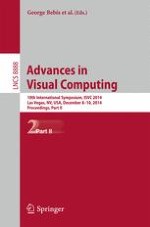The two volume set LNCS 8887 and 8888 constitutes the refereed proceedings of the 10th International Symposium on Visual Computing, ISVC 2014, held in Las Vegas, NV, USA. The 74 revised full papers and 55 poster papers presented together with 39 special track papers were carefully reviewed and selected from more than 280 submissions. The papers are organized in topical sections: Part I (LNCS 8887) comprises computational bioimaging, computer graphics; motion, tracking, feature extraction and matching, segmentation, visualization, mapping, modeling and surface reconstruction, unmanned autonomous systems, medical imaging, tracking for human activity monitoring, intelligent transportation systems, visual perception and robotic systems. Part II (LNCS 8888) comprises topics such as computational bioimaging , recognition, computer vision, applications, face processing and recognition, virtual reality, and the poster sessions.
